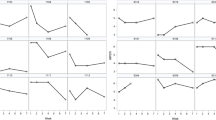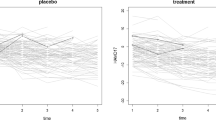Abstract
Incomplete data abound in epidemiological and clinical studies. When the missing data process is not properly investigated, inferences may be misleading. An increasing number of models that incorporate nonrandom incomplete data have become available. At the same time, however, serious doubts have arisen about the validity of these models, known to rely on strong and unverifiable assumptions. A common conclusion emerging from the current literature is the clear need for a sensitivity analysis. We propose in this paper a detailed sensitivity analysis using graphical and analytical techniques to understand the impact of missing-data assumptions on inferences. Specifically, we explore the influence of perturbing a missing at random model locally in the direction of non-random dropout models. Data from a psychiatric trial are used to illustrate the methodology.







Similar content being viewed by others
References
Albert, P.S., Follmann, D.A.: Modeling repeated count data subject to informative dropout. Biometrics 56, 667–677 (2000)
Ashford, J.R., Sowden, R.R.: Multivariate probit analysis. Biometrics 26, 535–546 (1970)
Brent, R.P.: Algorithms for minimization without derivatives. Prentice Hall, Englewood Cliffs, NJ (1972)
Burton, S.W.: A review of the Fluvoxamine and its uses in depression. Int. Clin. Psychopharmacol. 6(Supplement 3), 1–17 (1991)
Catalano, P.J., Ryan, L.M.: Bivariate latent variable models for clustered discrete and continuous outcomes. J. Am. Stat. Assoc. 87, 651–658 (1992)
Cook, R.: Assessment of local influence. J. Roy. Stat. Soc. B 48, 133–169 (1986)
Dale, J.: Global cross-ratio models for bivariate, discrete, ordered responses. Biometrics 42, 907–917 (1986)
Davidian, M., Giltinan, D.M.: Nonlinear models for repeated measurement data. Chapman & Hall Ltd (1998)
Davidon, W.: Variable metric methods for minimization. Technical Report ANL-5990, Argonne National Laboratory, Argonne, IL (1959)
Diggle, P., Kenward, M.G.: Informative dropout in longitudinal data analysis (with discussion). Appl. Stat. 43, 49–93 (1994)
Efron, B., Tibshirani, R.: An introduction to the bootstrap. Chapman and Hall, London (1993)
Ekholm, A., Jokinen, J., McDonald, J.W., Smith, P.: Joint regression and association modelling of longitudinal ordinal data. Biometrics 59, 795–803 (2003)
Fletcher, R., Powell, M.J.D.: A rapidly convergent descent method for minimization. Comput. J. CJ-6(2), 163–168 (1963)
Kenward, M.G., Goetghebeur, E.J.T., Molenberghs, G.: Sensitivity for incomplete categorical data. Stat. Model. 1, 31–48 (2001)
Lesaffre, E., Molenberghs, G., Dewulf, L.: Effects of dropouts in a longitudinal study: an application of a repeated ordinal model. Stat. Med. 15, 1123–1141 (1996)
Lesaffre, E., Todem, D., Verbeke, G.: Flexible modelling of the covariance matrix in a linear random effects model. Biometrical J. 42, 807–822 (2000)
Lindsay, B.G.: The geometry of mixture likelihoods: A general theory. The Annals of Statistics 11, 86–94 (1983)
Little, R., Rubin, D.: Statistical analysis with missing data. John Wiley and Sons, New York (1987)
Little, R.J., Rubin, D.B.: Adjusting for nonignorable drop-out using semiparametric nonresponse models: comment. J. Am. Stat. Assoc. 94, 1130–1132 (1999)
McCullagh, P., Tibshirani, R.: A simple method for the adjustment of profile likelihoods. J. Roy. Stat. Soc. B 52, 325–344 (1990)
Molenberghs, G., Kenward, M.G., Lesaffre, E.: The analysis of longitudinal ordinal data with non-random dropout. Biometrika 84, 33–44 (1997)
Morrell, C., Pearson, J.D., Brant, L.J.: Linear transformations of linear mixed effects models. Am. Stat. 51, 338–343 (1997)
Newton, M., Quintana, F., Zhang, Y.: Nonparametric Bayes methods using predictive updating. Springer, New York, (1998) in practical nonparametric and semiparametric bayesian statistics, dey, d., müller, p., and sinha, d.- edition.
Newton, M., Zhang, Y.: A recursive algorithm for nonparametric analysis with missing data. Biometrika 86, 15–26 (1999)
Plackett, R.L.: A class of bivariate distribution. J. Am. Stat. Assoc. 60, 516–522 (1965)
Rotnitzky, A., Scharfstein, D., Su, T.-L., Robins, J.: Methods for conducting sensitivity analysis of trials with potentially nonignorable competing causes of censoring. Biometrics 57, 103–113 (2001)
Scharfstein, D.O., Rotnitzky, A., Robins, J.M.: Adjusting for nonignorable drop-out using semiparametric nonresponse models (c/r: P1121-1146). J. Am. Stat. Assoc. 94, 1096–1120 (1999)
Tao, H., Palta, M., Yandell, B., Newton, M.: An estimation method for the semiparametric mixed effects model. Biometrics 55, 102–110 (1999)
Ten Have, T., Morabia, A.: Mixed effects models with bivariate and univariate association parameters for longitudinal bivariate binary response data. Biometrics 55, 85–93 (1999)
Ten Have, T.R., Reboussin, B.A., Miller, M.E., Kunselman, A.: Mixed effects logistic regression models for multiple longitudinal binary functional limitation responses with informative drop-out and confounding by baseline outcomes. Biometrics 58, 137–144 (2002)
Todem, D., Kim, K., Lesaffre, E.: Latent-variable models for longitudinal data with bivariate ordinal outcomes. Technical Report 169, Department of Biostatistics and Medical Informatics, University of Wisconsin-Madison (2002)
Verbeke, G., Molenberghs, G., Thijs, H., Lesaffre, E., Kenward, M.: Sensitivity analysis for nonrandom dropout: a local influence approach. Biometrics 57, 7–14 (2001)
Wu, M.C., Carroll, R.J.: Estimation and comparison of changes in the presence of informative right censoring by modeling the censoring process (corr: V45 p1347; V47 p357). Biometrics 44, 175–188 (1988)
Acknowledgments
The authors wish to thank Solvay Pharma B.V. for permission to use the data from the Fluvoxamine study.
Author information
Authors and Affiliations
Corresponding author
Appendices
Appendix 1
Numerical integration of the profile log-likelihood
In consideration of a bounded continuous mixing distribution, the Gauss–Legendre quadrature is chosen to approximate the integration. Reasonable lower and upper bounds of the integration can be obtained from the estimates of the standard deviation of a fully parametric normal model. Specifically, for each dimension of the random effects, the range of integration is chosen to be \((-5 SD_{\ell u}, 5 SD_{\ell u})\), where \(SD_{\ell u}\) is the estimated standard deviation of the uth normal random effects of the \(\ell\)th outcome. The corresponding product space approximately supports all probability mass of the mixing distribution. In confining the support of the random effects to a finite space, the starting density of the mixing distribution is chosen to be uniform given by
where \(r_{\ell}\), for \(\ell=1,2\) is dimension of the random effects design vector \(z_{\ell}\). When the random effects dimension \(r_{1}+r_{2}\) is large, say greater than 4, a Monte Carlo simulation is used to perform the integration. It is widely known that for higher dimensional integrals, the number of support points in a quadrature approach increases exponentially compared to that of a Monte Carlo approach, which increases only linearly.
Appendix 2
Optimization of the profile log-likelihood for fixed λ
The marginal non-ignorable log-likelihood for a sample of K independent subjects is given by
Although this non-ignorable log-likelihood is a continuous function of \((\alpha, \beta_3)\) for fixed λ, it involves recursive functions. Specifically, the smoothing parameter ν of the mixing distribution is imbedded in recursive functions, which do not allow explicit derivatives. Thus, maximizing the log-likelihood with respect to (α, β3) and the smoothing parameter ν using Newton–Raphson approach with analytical derivatives is proved to be a difficult task. We use the Davidon–Fletcher–Powell (DFP) method, which only requires evaluations of the objective function to search for an optimum point. This is a quasi-Newton method that builds up an approximation of the inverse Hessian and is often regarded as the most sophisticated approach for solving unconstrained problems. Earliest schemes for constructing the inverse Hessian was originally proposed by Davidon (1959) and later developed by Fletcher and Powell (1963). It has the interesting property that, for a quadratic objective, it simultaneously generates the directions of the conjugate gradient method while constructing the inverse Hessian. The method is also referred to as the variable metric method. The DFP method has theoretical properties that guarantee superlinear (fast) convergence rate and global convergence under certain conditions. It should be noted however, that this method could fail for general non-linear problems. Specifically, DFP is highly sensitive to inaccuracies in line searches and can get stuck on a saddle-point or may obtain only a local maximum. To address this issue, we used different starting values to examine whether the algorithm converges to the same point.
Finally, all the computations are performed assuming the bivariate probit model, but similar calculations can be done for the bivariate logistics model.
Rights and permissions
About this article
Cite this article
Todem, D., Kim, K. & Lesaffre, E. A sensitivity approach to modeling longitudinal bivariate ordered data subject to informative dropouts. Health Serv Outcomes Res Method 6, 37–57 (2006). https://doi.org/10.1007/s10742-006-0008-x
Received:
Revised:
Accepted:
Published:
Issue Date:
DOI: https://doi.org/10.1007/s10742-006-0008-x




